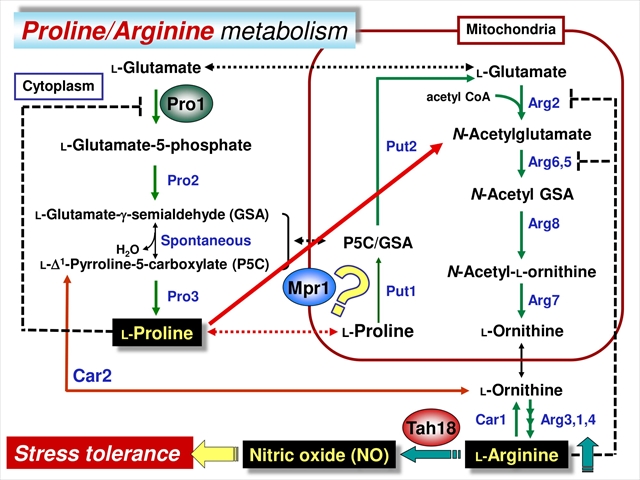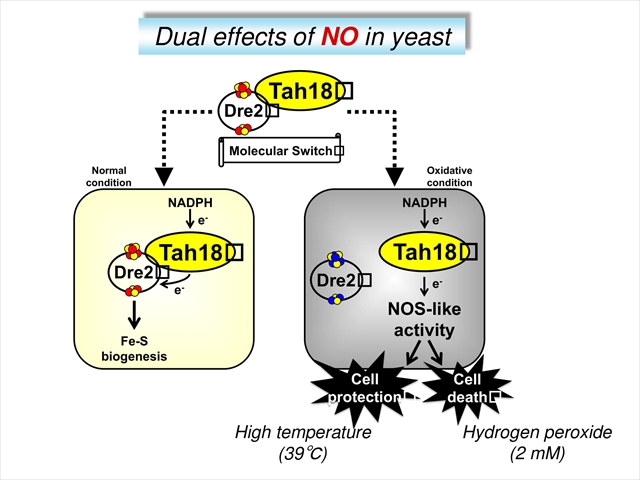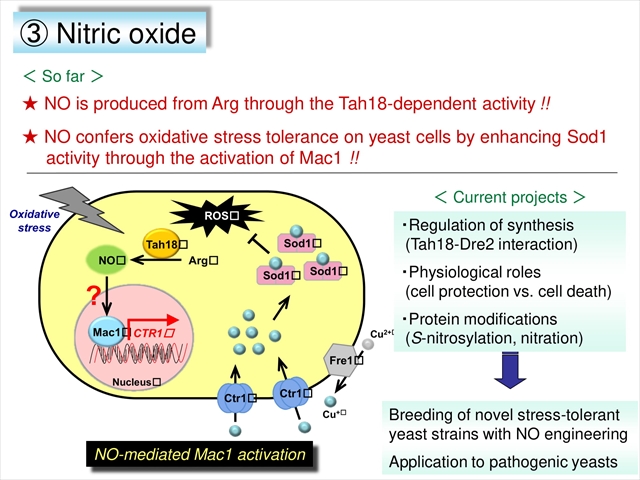Research Projects
1. Novel stress-tolerant mechanisms of yeast cells and their applications for breeding of industrial yeast
3) Nitric Oxide (NO): Synthetic regulatory mechanisms and physiological roles of NO in yeast and their applications to industrial yeast breeding and drug development
Nitric oxide (NO) is a signaling molecule involved in the regulation of many biological processes and NO is produced by NO synthase (NOS) in mammals. Research on NO in the yeast Saccharomyces cerevisiae, which is important as a model for higher eukaryotes and in fermentation industry, do not make progress due to the lack of mammalian NOS orthologues in the genome. We found that NO is synthesized through the flavoprotein Tah18-dependent NOS activity in yeast and that NO confers high-temperature tolerance on yeast via the transcription factor Mac1-mediated activation of the Cu,Zn-superoxide dismutase Sod1. We also proposed a novel regulatory mechanism of NO synthesis mediated by the Tah18-Dre2 complex. Furthermore, it was shown that he dual functions (cell protection vs. cell death) of NO found in higher eukaryotes also occur in yeast. In this study, for understanding of molecular functions of NO in yeasts and fungi, we will analyze the synthetic mechanisms and the physiological roles of NO. The effects of NO on fermentation ability of yeasts and on growth, infection and biologically active substances production in fungi will be investigated for contribution to breeding of industrial yeasts and development of antifungal agent.
https://www.jsps.go.jp/j-grantsinaid/12_kiban/ichiran_r01/e-data/r_1_eng_19h05639.pdf
Eukaryotes utilize two distinct isoforms of aminoacyl-tRNA synthetase, because protein synthesis occurs both in cytosol and in mitochondria. However, S. cerevisiae genome possesses only one cysteinyl-tRNA synthetase gene (YNL247W, now known as CRS1). Recently, CRS1 was discovered to encode both cytosolic and mitochondrial isoforms. Our current study suggests a novel mechanism for an energy-dependent alternative initiation for production of two Crs1 isoforms, which may thus indicate the potential involvement of Crs1 in mitochondrial energy metabolism in yeast.



- Y. Yoshikawa, R. Nasuno, N. Takaya and H. Takagi: Metallothionein Cup1 attenuates nitrosative stress in the yeast Saccharomyces cerevisiae. Microbial Cell, 10, 170-177 (2023).
- S. Shino, R. Nasuno and H. Takagi: S-Glutathionylation of fructose-1,6-bisphosphate aldolase confers nitrosative stress tolerance on yeast cells via a metabolic switch. Free Radic. Biol. Med., 193, 319-329 (2022).
- S. Oiki, R. Nasuno, S. Urayama, H. Takagi and D. Hagiwara: Intracellular production of reactive oxygen species and a DAF-FM-related compound in Aspergillus fumigatus in response to antifungal agent exposure. Sci. Rep., 12, 13516 (2022).
- R. Nasuno, Y. Yoshikawa and H. Takagi: Acetaldehyde reacts with a fluorescence nitric oxide probe harboring o-phenylenediamine structure interfering with fluorometry. Free Radic. Biol. Med., 187, 29-37 (2022).
- S. Eknikom*, R. Nasuno* and H. Takagi: Molecular mechanism of ethanol fermentation inhibition via protein tyrosine nitration of pyruvate decarboxylase by reactive nitrogen species in yeast. Sci. Rep., 12, 4664 (2022).
- R. Nasuno, S. Suzuki, S. Oiki, D. Hagiwara and H. Takagi: Identification and functional analysis of GTP cyclohydrolase II in Candida glabrata in response to nitrosative stress. Front. Microbiol., 13, 825121 (2022)
- R. Nasuno, N. Yoshioka, Y. Yoshikawa and H. Takagi: Cysteine residues in the fourth zinc finger are important for activation of the nitric oxide-inducible ranscription factor Fzf1 in the yeast Saccharomyces cerevisiae. Genes Cells, 26, 823-829 (2021).
- R. Nasuno, N. Iwai and H. Takagi: Development of a microtiter plate-based analysis method of nitric oxide dioxygenase activity. J. Gen. Appl. Microbiol., 68, 38-41 (2022).
- Y. Yoshikawa, R. Nasuno and H. Takagi: NADPH is important for isobutanol tolerance in a minimal medium of Saccharomyces cerevisiae. Biosci. Biotech. Biochem., in press. 85, 2084-2088 (2021).
- Y. Yoshikawa, R. Nasuno and H. Takagi: An NADPH-independent mechanism enhances oxidative and nitrosative stress tolerance in yeast cells lacking glucose-6-phosphate dehydrogenase activity. Yeast, 38, 414–423 (2021).
- R. Nasuno, Y. Yoshikawa and H. Takagi: The analytical method to identify the nitrogen source for nitric oxide synthesis. Biosci. Biotech. Biochem., 85, 211-214 (2021). DOI: 10.1093/bbb/zbaa046.
- R. Nasuno, S. Shino, Y. Yoshikawa, N. Yoshioka, Y. Sato, K. Kamiya and H. Takagi: Detection system of the intracellular nitric oxide in yeast by HPLC with a fluorescence detector. Anal. Biochem., 598, 113707 (2020). DOI: 10.1016/j.ab.2020.113707
- R. Nasuno, S. Shino, Y. Yoshikawa, N. Yoshioka, Y. Sato, K. Kamiya and H. Takagi: Detection system of the intracellular nitric oxide in yeast by HPLC with a fluorescence detector. Anal. Biochem., in press. DOI: 10.1016/j.ab.2020.113707
- K. Anam, R. Nasuno and H. Takagi: A novel mechanism for nitrosative stress tolerance dependent on GTP cyclohydrolase II activity involved in riboflavin synthesis of yeast. Sci. Rep., 10, 6015 (2020). DOI: 10.1038/s41598-020-62890-3
- A. Nishimura, R. Nasuno, Y. Yoshikawa, M. Jung, T. Ida, T. Matsunaga, M. Morita, H. Takagi, H. Motohashi and T. Akaike*: Mitochondrial cysteinyl-tRNA synthetase is expressed via alternative transcriptional initiation regulated by energy metabolism in yeast. J. Biol. Chem., 294, 13781-13788 (2019).
- D. Hagiwara*, H. Takahashi, H. Takagi, A. Watanabe and K. Kamei: Heterogeneity in pathogenicity-related properties and stress tolerance in Aspergillus fumigatus clinical isolates. Med. Mycol. J., 59, E63-E70 (2018).
- R. I. Astuti*, R. Nasuno* and H. Takagi: Nitric oxide signaling in yeast. *These authors contributed equally to this work. Adv. Microb. Physiol., 72, 29-63 (2018).
- R. I. Astuti*, R. Nasuno*, and H. Takagi: Nitric oxide signaling in yeast. *These authors contributed equally to this work. Appl. Microbiol. Biotech., 100, 9483-9497 (2016).
- Y. Yoshikawa*, R. Nasuno*, N. Kawahara, A. Nishimura, D. Watanabe, and H. Takagi: Regulatory mechanism of the flavoprotein Tah18-dependent nitric oxide synthesis and cell death in yeast. *These authors contributed equally to this work. Nitric Oxide-Biol. Chem., 57, 85-91 (2016).
- R. I. Astuti*, D. Watanabe*, and H. Takagi: Nitric oxide signaling and its role in oxidative stress response in Schizosaccharomyces pombe. *These authors contributed equally to this work. Nitric Oxide-Biol. Chem., 52, 29-40 (2016).
- R. Nasuno, M. Aitoku, Y. Manago, A. Nishimura, Y. Sasano and H. Takagi: Nitric oxide-mediated antioxidative mechanism in yeast through the activation of the transcription factor Mac1. PLoS One, 9(11), e113788 (2014).
- D. Watanabe, R. Kikushima, M. Aitoku, A. Nishimura, I. Ohtsu, R. Nasuno and H. Takagi: Exogenous addition of histidine reduces copper availability in the yeast Saccharomyces cerevisiae. Microbial Cell, 1, 241-246 (2014).
- H. Kitagaki and H. Takagi: Mitochondrial metabolism and stress response of yeast: Applications in fermentation technologies. J. Biosci. Bioeng., 117, 383-393 (2014).
- A. Nishimura, N. Kawahara and H. Takagi: The flavoprotein Tah18-dependent NO synthesis confers high-temperature stress tolerance on yeast cells. Biochem. Biophys. Res. Commun., 430, 137-143 (2013).
- A. Nishimura, R. Nasuno and H. Takagi: The proline metabolism intermediate 1-pyrroline-5-carboxylate directly inhibits the mitochondrial respiration in budding yeast. FEBS Lett., 586, 2411-2416 (2012).
- Y. Sasano*, Y. Haitani*, K. Hashida, I. Ohtsu, J. Shima and H. Takagi: Enhancement of the proline and nitric oxide synthetic pathway improves fermentation ability under multiple baking-associated stress conditions in industrial baker's yeast. *These authors contributed equally to this work. Microb. Cell Fact., 11:40 doi:10.1186/1475-2859-11-40 (2012).
- A. Nishimura, T. Kotani, Y. Sasano and H. Takagi: An antioxidative mechanism mediated by the yeast N-acetyltransferase Mpr1: Oxidative stress-induced arginine synthesis and its physiological role. FEMS Yeast Res., 10, 687-698 (2010).
